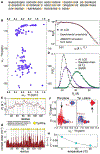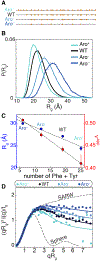Valence and patterning of aromatic residues determine the phase behavior of prion-like domains
- PMID: 32029630
- PMCID: PMC7297187
- DOI: 10.1126/science.aaw8653
Valence and patterning of aromatic residues determine the phase behavior of prion-like domains
Abstract
Prion-like domains (PLDs) can drive liquid-liquid phase separation (LLPS) in cells. Using an integrative biophysical approach that includes nuclear magnetic resonance spectroscopy, small-angle x-ray scattering, and multiscale simulations, we have uncovered sequence features that determine the overall phase behavior of PLDs. We show that the numbers (valence) of aromatic residues in PLDs determine the extent of temperature-dependent compaction of individual molecules in dilute solutions. The valence of aromatic residues also determines full binodals that quantify concentrations of PLDs within coexisting dilute and dense phases as a function of temperature. We also show that uniform patterning of aromatic residues is a sequence feature that promotes LLPS while inhibiting aggregation. Our findings lead to the development of a numerical stickers-and-spacers model that enables predictions of full binodals of PLDs from their sequences.
Copyright © 2020 The Authors, some rights reserved; exclusive licensee American Association for the Advancement of Science. No claim to original U.S. Government Works.
Conflict of interest statement
Figures




References
Publication types
MeSH terms
Substances
Grants and funding
LinkOut - more resources
Full Text Sources
Other Literature Sources
Research Materials

